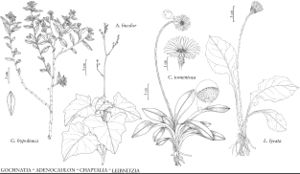Adenocaulon
Bot. Misc. 1: 19, plate 15. 1829.
| Taxon | Illustrator ⠉ | |
|---|---|---|
 | Gochnatia hypoleuca Adenocaulon bicolor Chaptalia tomentosa Leibnitzia lyrata | Yevonn Wilson-Ramsey Yevonn Wilson-Ramsey Yevonn Wilson-Ramsey Yevonn Wilson-Ramsey |
Perennials (perhaps flowering first-year, usually rhizomatous), (10–) 30–60 (–100+) cm (aerial stems usually proximally tomentose and distally stipitate-glandular). Leaves basal and cauline; petiolate (proximal) or sessile (distal); blades ovate to ± triangular [suborbiculate], bases mostly truncate to cordate or hastate, margins coarsely dentate or lobulate to denticulate or entire, abaxial faces tomentose, adaxial faces glabrate (distalmost leaves often linear or scalelike). Heads disciform, borne in open paniculiform arrays. Involucres cuplike to saucer-shaped (inconspicuous), 4–8+ mm diam. Phyllaries in 1–2 series, ovate to oblong, ± equal (reflexed in fruit), apices obtuse. Receptacles convex, smooth, glabrous, epaleate. Florets: outer 3–7 florets pistillate, corollas white or ochroleucous, obscurely zygomorphic (± 2-lipped; staminodes 4–5, minute; style-branches relatively short); inner 2–10 florets functionally staminate, corollas white or ochroleucous, actinomorphic (lobes 5); anther basal appendages (relatively short) entire, apical appendages narrowly triangular; style-branches none (apices of styles obtuse to acute). Cypselae clavate to obovoid, not beaked, ± ribbed, faces distally stipitate-glandular; pappi 0. x = 23.
Distribution
North America, Central America, s South America, e Asia
Discussion
Species 5 (1 in the flora).
Adenocaulon is well adapted for animal dispersal. The prominent glandular hairs on the cypselae are very sticky and cling readily to fabrics, fur, and feathers. The intercontinental disjunctions within the range of Adenocaulon are probably a result of dispersal of cypselae on the feathers of birds. Bird dispersal may also account for the intracontinental disjunctions of A. bicolor (in the Pacific Northwest, the Black Hills, and the northern Great Lakes region). An alternate hypothesis for the disjunctions of A. bicolor is a former transcontinental periglacial distribution that was broken apart by Holocene climatic changes.